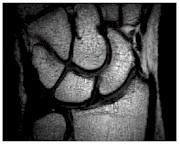
High resolution MR image of the wrist
Carpal tunnel syndrome is characterized by numbness, tingling and pain in the thumb, index and middle fingers that often worsens at night. The condition may affect one or both hands and is sometimes accompanied by weakness in the thumb(s). Carpal tunnel syndrome may be caused by such repetitive tasks as frequent or prolonged use of a keyboard without proper support or position of the wrist. Other work that requires repeated forceful movements with the wrist extended, such as using a screwdriver, may cause carpal tunnel syndrome.
The condition results from pressure on the median nerve where it passes into the hand via a gap (the "carpal tunnel") under a ligament at the front of the wrist. The median nerve carries sensory messages from the thumb and some fingers and also motor stimuli to the muscles in the hand. Damage to the median nerve can cause sensory disturbances such as numbness, tingling and pain.
Carpal tunnel syndrome usually occurs most commonly in middle aged women, typically for no obvious reason. Carpal tunnel syndrome often resolves itself without treatment. However, magnetic resonance (MR) imaging of the wrist may be used to diagnose carpal tunnel syndrome. MR imaging can show compression of the median nerve.
The disorder is best treated by avoiding positions or tasks that hyperextend the wrist or put extra pressure on the median nerve. Such measures as adjusting the angle of the computer keyboard may help, as can the use of wrist splints. Treatment of carpal tunnel syndrome may involve injections of corticosteriods under the ligament in the wrist or into the median nerve. If pain is severe or if the muscle atrophies or weakens, surgery may be used to relieve pressure on the nerve. A surgeon releases the bands of fibrous tissue that place pressure on the median nerve.
Updated: November 2, 2007



